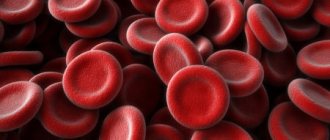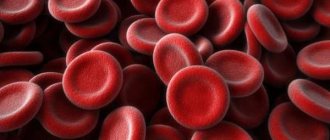Lymphocytes in the blood: normal in children
An important indicator in test results is the number of lymphocytes and white blood cells. They are responsible for the presence of foreign pathogenic irritants in the body. Based on a signal from lymphocytes, the immune system organizes a response to detected harmful bacteria and infection. To do this, the norm of lymphocytes in the blood of children must fully correspond to age data.
Lymphocytes are deservedly part of the immune system because they fight foreign stimuli at the cellular level, produce antibodies to foreign “agents,” and sacrifice themselves in order to save the body from disease.
Lymphocytes are produced by the bone marrow and lymph nodes. The number of lymphocytes in the blood of children and adults changes due to various diseases and inflammation developing in the body.
The number of lymphocytes depends on the activity of the immune system: when antibodies are actively produced, the number of white blood cells increases; in a situation of inflammation, it decreases significantly.
Parameter norm
On average, the normal MCV parameter for different categories of people of different ages varies from 70 to 110 fl. Moreover, in some cases, the parameter may show an underestimated or, conversely, an overestimated value, but this will not be due to deviations in the health of the person being tested, but to the characteristics of the body, which is very often observed in a child.
The table shows the norms for the average volume of red blood cells for different ages and gender
| Floor | Age | Norma, fl |
| Children | Less than 1 year | 71-112 |
| 1-5 years | 73-85 | |
| 5-10 years | 75-87 | |
| 10-12 years | 76-94 | |
| Women | 12-15 years | 73-95 |
| 15-18 years old | 78-98 | |
| 18-45 years old | 81-100 | |
| 45-65 years | 81-101 | |
| Over 65 years old | 81-102 | |
| Men | 12-15 years | 77-94 |
| 15-18 years old | 79-95 | |
| 18-45 years old | 80-99 | |
| 45-65 years | 81-101 | |
| Over 65 years old | 81-102 |
Sometimes the patient may experience severe symptoms of anemia, but the MCV shows the optimal value of the parameter. This can happen in the following cases:
- Tumors;
- Loss of blood in large quantities;
- Hemoglobinopathy and its background disorder of protein structure;
- Chronic infections;
- Diseases that appear as a result of hormonal disruptions in the thyroid gland, adrenal glands, etc.
How many lymphocytes should a child have?
At a young age, the number of white blood cells in a child is quite high; as the baby grows, the number of lymphocytes in the baby’s blood gradually decreases. The norm of lymphocytes in the blood of children under one year of age is a separate topic of conversation, because in the 1st week of life the number of white blood cells is only 20-22%, and only by the age of one year it gradually increases to 37-60%.
The increase in the number of lymphocytes continues until the age of 4, when their content begins to be approximately 50%, and only after that the number of white blood cells begins to slowly decrease: by 6 years to 42%, by 10 years to 38% , and older – already almost equal to the adult age norm – about 30%.
The main feature of lymphocytes is that they can “travel” throughout the body, pass through different tissues, and monitor the health and functionality of the immune system. They quickly react to encounters with foreign microorganisms and infections. Another feature that distinguishes white cells from other blood components is their maximum vitality.
Their life cycle lasts more than 20 years, and many accompany human internal processes throughout their lives.
This is important for 1-year-old children, in whom the norm of lymphocytes in the blood is approximately 50%, and they require high body protection from microbes and infections.
In this they are helped by white cells, the main elements of the blood that carry out immune surveillance. Lymphocytes are divided into 3 groups according to their functions: T-, B- and zero lymphocytes. White blood cells should always be in the blood within the age range; their deviation from the norm in one direction or another should alert parents.
Changes in white blood cell values indicate the detection of a serious disease. It is not for nothing that routine medical examinations in kindergarten and school include, first of all, blood donation for clinical analysis.
Types of lymphocytes
Depending on their location and function, all leukocytes are divided into:
- B cells. They are found mainly in the lymph nodes and make up about 8-20% of all lymphocytes. The main task of these cells is to provide humoral immunity. When B lymphocytes independently come into contact with antigens or are stimulated by T lymphocytes, antibody production begins. Memory B cells are also secreted. Having encountered an infectious agent, such cells record information about it, due to which children develop post-infectious and post-vaccination immunity.
- T cells. Their main location is the thymus, and their main function is to provide cellular immunity. Such lymphocytes are the most numerous, since they constitute up to 80% of all cells of this species. They are divided into T-killers (the main “job” of such lymphocytes is the destruction of pathogenic cells), T-helpers (such lymphocytes help T-killers and secrete active substances) and T-suppressors (these cells suppress immune reactions so that healthy cells are not destroyed ).
- NK cells. Such lymphocytes destroy the child’s own cells that are infected or transformed into tumor cells. They occupy less than 10-20% of all lymphocytes.
Prepare for a blood test
To determine the number of Lymphocytes in the blood and the norm in children, the indicator of white blood cells is calculated based on the results of a clinical analysis, which is taken from the phalanx of the ring finger, or from the heel in infants.
The laboratory technician counts 2 indicators: the number of white cells and their percentage in the total mass of leukocytes.
Before taking the test, you should not eat for about 8 hours; for infants, the fasting time is 2 hours. Do not give your child fried or salty foods 2 days before donating blood.
Do not take the pills in the morning until the laboratory technician takes your blood for analysis. If drug treatment is carried out, then the best option is to donate blood 2 weeks after the end of drug treatment.
On the eve of the test, avoid physical activity and nervous stress. Children of 2 years have enough patience to endure the morning hungry, but the norm of lymphocytes in the blood will be calculated with absolute accuracy.
Healthy children undergo tests at an annual preventive examination, children with chronic pathology - 2 times a year.
Blood is taken for analysis several times:
- during long-term therapy of any disease with complications;
- when making a diagnosis;
- when checking the success of treatment.
The importance of lymphocytes is to perform immune functions. Each time the doctor “reads” the analysis results, compares the data obtained with previous results, with standard indicators, and draws a conclusion about the child’s condition.
If the lymphocyte count is increased in children
An increased number of lymphocytes in the blood indicates various diseases:
- "children's" infectious diseases;
- dangerous infections;
- stage of recovery after illness;
- pathology of endocrine organs.
When, as a result of tests, a large number of atypical lymphocytes is noted, this indicates the presence of infectious mononucleosis. This acute viral pathology often affects young children.
This is how the child’s body reacts to infectious foreign “agents” that irritate internal organs and cause the development of changes in the form of tumors. Based on different reactions, reactive and chronic lymphocytosis are distinguished, which differ only in the causes of development.
The reactive form of an increase in the norm of lymphocytes in the blood in children 3 years old is most often a protective reaction of the child’s body to a developing disease. The number of white cells returns to normal values when the child recovers from a viral illness. Lymphocytosis as an independent disease can only be diagnosed by a doctor using additional diagnostic methods.
Symptoms and causes of lymphocytosis (increased lymphocyte levels)
The increase in immune cells is called lymphocytosis. In infants, this phenomenon does not have pronounced symptoms. In children aged 2 years and older, lymphocytosis manifests itself as:
- weakness, lethargy, apathy;
- difficulty breathing;
- rashes on the skin;
- enlarged lymph nodes;
- attacks of nausea and vomiting;
- diarrhea or diarrhea;
- sudden changes in body temperature;
- disturbances in sleep and wakefulness;
- moodiness;
- prolonged crying.
In babies, lymphocytosis can manifest itself as prolonged crying and causeless moodiness.
Experts cannot accurately name the causes of lymphocytosis. The most likely factors provoking this phenomenon include:
- childhood infectious diseases (smallpox, whooping cough, rubella, measles);
- dangerous diseases (typhoid, toxoplasmosis, viral hepatitis, tuberculosis);
- disorders of the endocrine and central nervous system;
- rehabilitation period after an infection;
- emotional and physical stress;
- intoxication of the body.
If the lymphocyte count is low
A decrease in white blood cell counts is called lymphopenia. Most often it affects children under 5 years of age, when there is no normal level of lymphocytes in the blood due to undeveloped immunity, with a weak ability to protect the body. The final formation of the immune system is completed by 6-7 years of age. Until this time, the functions of the immune system are supported in the child’s body by the work of white cells.
Disturbances in the production of lymphocytes are also observed in the presence of inherited diseases of the immune system, or as a consequence of a severe infectious cold with an inflammatory component of the disease.
There is an outflow of lymphocytes to diseased organs to fight the disease, and in the blood their number sharply decreases. A low number of white blood cells in children indicates a weakened immune system, the development of diseases in the child’s body that suppress the functions of the immune system and internal organs that produce white blood cells.
Signs of a low number of lymphocytes manifest themselves in the child’s weakness and poor general health. For a doctor, indicative symptoms are a decrease in the size of the tonsils and lymph nodes, pale skin, and frequent colds.
The role of lymphocytes
This is the name given to a group of blood cells, which is one of the types of leukocytes. Such cells do not include granules, therefore, together with monocytes, they are classified as agranulocytes. Lymphocytes are important for:
- Creation of local immunity.
- Protecting the body through the production of antibodies or direct destruction of foreign agents.
- Controlling the cells of the child’s body, thanks to which pathological structures are destroyed.
- Formation of immunity after diseases or administration of vaccines.
Watch a short video showing how lymphocytes work:
Reasons for deviations in the number of lymphocytes
Diseases that provoke changes in the number of white blood cells in children include: infections and viruses, the stage of recovery after a serious illness, asthma, vitamin deficiency. Factors that cause changes in lymphocytes are poor nutrition, stress, and air deficiency.
The clinical picture of a violation of the number of lymphocytes may occur without symptoms, or be similar to the symptoms of a disease that provoked a change in the number of white blood cells. Often, changes in the number of lymphocytes in children are determined only by tests. It is necessary to monitor the levels of lymphocytes in the blood as normal in children.











